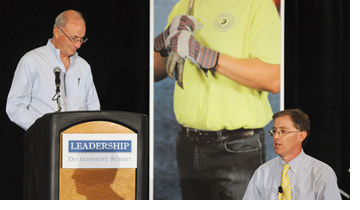
2013 Leadership Summit
Individuals influence organizational culture

ITD began a steady transition toward a “blue” culture the past year. But what does that mean, how do we get there and how will we know when we arrive?
Jim Johnson created the Organizational Culture Inventory to assess the characteristics of an organization. The cultural survey, completed by a random group of ITD employees last year, identified the department’s attributes and plotted a course toward the desired culture.
Jay Otto, a research scientist and managing director for the Center of Health and Safety Culture at Montana State University, has been working with ITD’s Office of Highway Safety to develop a new approach to influencing driver behavior. His emphasis is on changing those behaviors by changing the driving culture.
Johnson and Otto combined efforts last week at the 2013 ITD Leadership Summit to demonstrate the relationship between organizational culture and personal behavior. They conducted a live, electronic poll of participants that automatically registered and plotted their responses.
The survey showed a disparity between the personal beliefs of employees and how they perceived the department operates.
Johnson’s unique “circumplex,” divides a circle into 12 sections; one-third represent passive and defensive behaviors and beliefs; one-third corresponds with aggressive/defensive styles; and one-third relates to constructive styles. Many organizations have characteristics predominately in one of the first two categories.
Strong, successful, rewarding organizations exemplify characteristics in the "constructive" segment of the circumplex. ITD has identified that section, represented in blue, as its desired culture.
Its styles include a commitment to achievement, self-actualization, humanistic/encouraging and affiliative behaviors. Employees are supportive, set challenging but realistic goals and solve problems effectively, are open and sensitive to the satisfaction of groups, derive satisfaction from their work and are committed to high-quality products and services.
“Culture influences the decisions we make,” Otto said. Individuals also influence the organizational culture, looping individual performances to leadership.
“People are partly the products of their environments, but by selecting, creating and transforming their environmental circumstances, they are producers of environments as well,” Johnson said, referring to research by psychologist Albert Bandura.
According to organizational authority Stephen Covey, “Management works in the system; leadership works on the system.”
Among the results of the electronic poll, 72 percent of the summit attendees indicated they strongly believe they have an important role in influencing the organization’s culture. Another 21 percent they generally agree, which means that 93 percent of the attending employees believe they help shape ITD’s culture.
ITD plans a more comprehensive culture survey next year.
Published 10-11-13